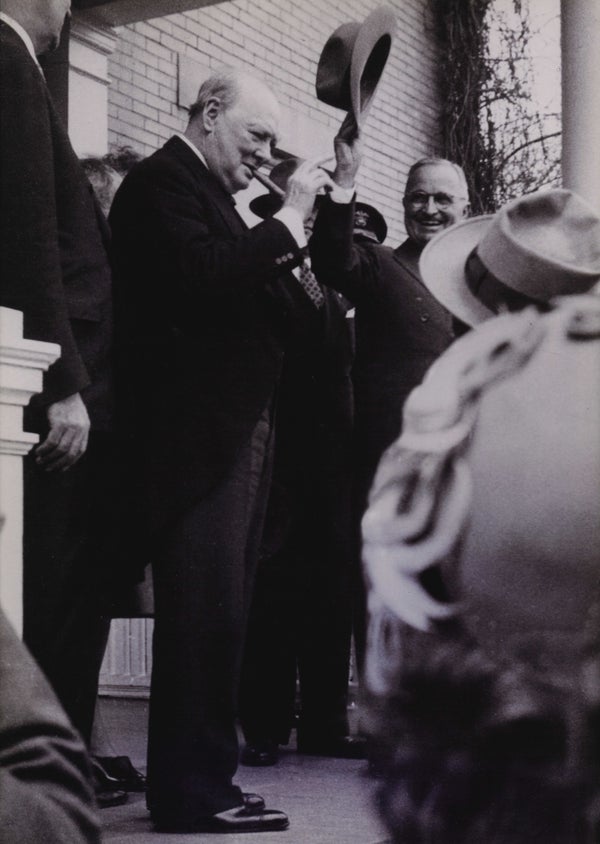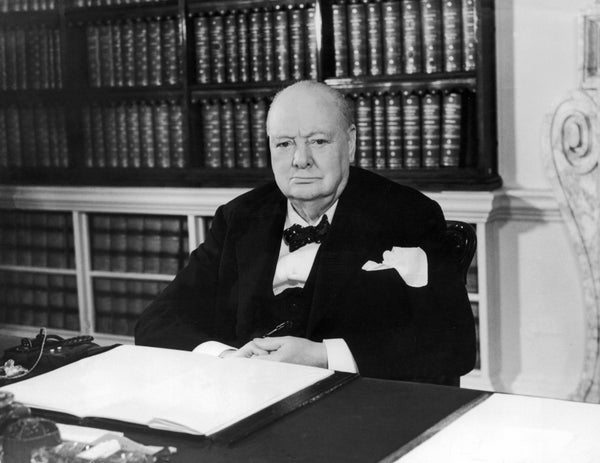This article was published in Scientific American’s former blog network and reflects the views of the author, not necessarily those of Scientific American
In 2016 I had the privilege of being handed a previously unpublished essay by Winston Churchill, entitled Are We Alone in the Universe? That unexpected honor occurred during a visit I made to the U.S. National Churchill Museum in Fulton, Mo. The museum's director, Timothy Riley, asked me to examine the essay and to provide comments. The experience resulted in an article published in Nature on February 15, 2017.
At the time, Riley did inform me that the museum's archive was also in possession of a second essay, which to the best of his knowledge had not been previously published. Out of sheer curiosity, I inquired in 2019 whether that second essay had been scrutinized in the meantime, and upon discovering that it had not, I asked whether I would be allowed to examine it too. Riley graciously agreed.
The 14-page typewritten manuscript was entitled The River of Life, and was devoted to the evolution of life on Earth. Like the first essay, this one was written originally in 1939 and then slightly revised by Churchill in the 1950s. Given the fact that the topic of evolution still provokes controversy in certain circles even today, needless to say I was extremely curious to read Churchill's opinions on this scientific subject.
On supporting science journalism
If you're enjoying this article, consider supporting our award-winning journalism by subscribing. By purchasing a subscription you are helping to ensure the future of impactful stories about the discoveries and ideas shaping our world today.
As with his essay on alien life, however, I quickly discovered that while some of the details were wrong or inaccurate (in particular those related to the timescales involved—not surprising, as the article was written at a time when some of the relevant information was still not known), Churchill had a superb grasp of the big picture, and his views were not colored at all by any nonscientific arguments or sentiments.
We may wonder today what it was that made Churchill such a unique statesperson (for example, no other prime minister did more for science, technology and innovation). In my humble opinion, it might have been the fact that in science and indeed also in his art, he was able to find a life outside the daily fray.

Winston Churchill and President Harry Truman at Westminster College, Fulton, MO March 5, 1946. Credit: Baxter Brown Watson America’s National Churchill Museum
Early Life Forms
Churchill starts his brief description of life's history with an account of how the Earth itself formed, cooled down, and settled into the relatively quiescent state which allowed life to take root. As in his essay on alien life, he mentions an old theory for the formation of planets, according to which planets form from gas torn off the edges of their host star by the tidal forces exerted by a passing errant star. He also thought that the oceans condensed out of the steamy atmosphere that surrounded the primeval Earth.
Today the prevailing theory is that rocky planets such as the Earth form via the coalescence of dust particles in the disk that surrounded the young star (the sun in the Earth's case), followed by the formation of planetesimals, which then further merge together. There is strong observational evidence suggesting that most of the Earth's surface water was delivered to Earth via asteroid (and perhaps also comet) impacts.
Next, Churchill demonstrates a familiarity with the idea that plate tectonics (continental drift) was responsible for the generation of mountain chains. I found this to be quite remarkable in itself, since even the geophysics community accepted the theory of plate tectonics (continental drift was originally suggested in 1912) only in the late 1950s.
After these preliminaries, Churchill arrives at the main topic of life on Earth. Here he starts with the correct and important observation, "how life came into being is still a complete mystery." That is, indeed even today there is no generally accepted theory for the origin of life, in spite of impressive advances in prebiotic chemical synthesis (for a recent update, see Jack Szostak's talk from the More to Explore). Churchill mentions the possibility of panspermia—the idea that life on Earth originated from some precursors of life that were present in outer space.
This theory was, in fact, favored by the astrophysicists Fred Hoyle and Chandra Wickramasinghe (summarized, for instance, in Wickramasinghe's article in More to Explore, below). Churchill does acknowledge, however, that this "merely pushes the problem one stage further back." He then follows this remark with the insight that "whatever the process, clearly the earliest form must have been of the type capable of drawing its sustenance out of non-living matter." Because, he explains, "with all our knowledge of chemistry we could not produce a meal from a few cupfuls of chalk and salt."
All of this, he realizes, could not work without a reliable energy source. So to the very basic ingredients, he is quick to add "the most important of the lot—sunshine." After a brief description of photosynthesis, emphasizing the importance of chlorophyll in this process, Churchill therefore concludes in his wonderfully colorful language that, "the struggle for life in the case of plants is reduced to a struggle for light, and in any forest we can see them jostling one another in their endeavors to get the best positions."
In the next stage, Churchill starts to discuss evolution proper, and it is there in particular where he shows a modern understanding of all the concepts involved.
Churchill the Darwinist
Darwinian evolution is based on and characterized by four pillars, and those are supported by one grand mechanism (in the More to Explore for example, see the annotated Darwin book and also Jerry Coyne's book for clear explanations). Those four pillars are: evolution, gradualism, common descent and speciation. Evolution encapsulates the idea that species are not immutable. The species we see today didn't always exist. In fact, most species that existed in the past have become extinct. Today we see only the species that have evolved from those.
Gradualism expresses a concept that Darwin adopted from his geologist friends. In the same way that the sun, the wind, the rain, and geological processes slowly shape the surface of the Earth, evolution works slowly. It can take many thousands of generations for one species to evolve into another. Common descent means that even the enormous diversity of species we see today (on the order of ten million) all started from one life form. Finally, speciation refers to branching, when one species bifurcates into two different species. Since at every such branching node the number of species is doubled, this accounts for the rich variety we see today. The one fundamental mechanism on which all of this picture relies is natural selection.
Churchill demonstrates a remarkable comprehension of all of these concepts. In fact, we know that already at age 22, while stationed with the British army in India, he read Darwin's masterpiece On the Origin of Species by Means of Natural Selection.
Churchill writes, "very early, no doubt, modifications of the simplest bacteria appeared, from which rudimentary microbic organisms developed, able to feed upon the plants or their decaying remnants," to which he immediately adds, "this was probably the earliest bifurcation in the great tree of life, separating the plants from animals." He then goes on to describe in some detail the operation of natural selection.
For instance, he notes perceptively that "the problem of how life evolved from what we in our arrogance call 'lower' to higher forms is very much simpler than the question of how it first formed." He explains that in every generation there are some members that have somewhat different characteristics than the ordinary. He then elucidates that if a certain characteristic confers on its bearers an advantage in terms of, say, coping with the environment and in terms of producing offspring, then after many generations the entire population would shift toward that characteristic.
Churchill recognized that it is difficult to prove that the early stages of evolution indeed took place: "Direct evidence, of course, we have none. For it is only creatures with hard, bony shells or skeletons whose traces in fossil form remain." He did point out, however, that indirect evidence could be traced to creatures such as sponges (that survive even if cut into pieces), which were later followed by marine creatures similar perhaps to sea anemones.
After a brief discussion of how locomotion may have produced a difference between fore and aft in animals (but not mentioning the fact that the Earth's gravity probably produced the difference between up and down), Churchill discusses a few possible branching events, an important one being between snail-like creatures with external shells, and those species which developed backbones.
Just like a veteran scientist, throughout this description Churchill repeatedly emphasizes the crucial importance of observational and experimental evidence, noting that "though, of course, we cannot trace every step in the record of the rocks … many of these stages of development can be followed in amazing detail." He also recognizes that natural selection is the key driver for change, noting that as life started to adapt to land, "amid all the minor mutations and varieties in every fresh generation, those best able to cope with the increasing aridity gradually replaced the older species."
We Humans Are Nothing Special
Perhaps the most fascinating part in Churchill's essay is his treatment of the appearance of humans. The key point is that he fully accepts the fact that like every other life form, humans are simply a natural product of Darwinian evolution. Already early on in his essay he remarks that "even you and I descend from the somewhat clumsy-looking inhabitants of the sea."
In his step-by-step exposition of the history of life on Earth, Churchill goes through a vivid description of the biologically cold-blooded dinosaurs—"great grisly monsters of fantastic shapes and nightmare appearance"—and suggests that their demise was brought about by the extreme temperature changes that resulted from geological events. Today we have convincing evidence that the extinction of the dinosaurs was the result of an asteroid impact near the Yucatan peninsula, which generated a nuclear-winter-like darkening of the Earth's skies.
Irrespective of the precise cause, Churchill correctly deduces that warm-blooded mammals, from rabbits and rats to elephants and lions started thriving. From one branch of monkeylike creatures, he concludes, "flow the various streams which lead some to the modern monkeys, some to the great apes, and one, at least, to man."
In this essay, Churchill decided not to discuss in any detail later stages of human evolution. He does mention, however, "misfits, which have died out, Neanderthal Man, for instance." More important, he notes in admiration that the 15,000-year-old drawings of animals on the walls of caves in southeastern France and northern Spain, created by "fine upstanding men and women," do not fall in quality from "the art of today."
In his inimitable style, Churchill finishes the essay with a few sentences that are as relevant for today as they were just before World War 2. He points out that the evolution of life on Earth demonstrates that: "In storm and stress new types, more highly organized, have ever emerged able to survive the buffets of Fate.," and therefore, "in days of doubt and depression comfort may be found in this thought and in the study of our story written in the rocks on a time-scale which counts a million years but as a watch in the night."
Great thoughts. But if we want to follow Churchill's example, this optimism should also be accompanied by the right actions!
